Marina Abramović
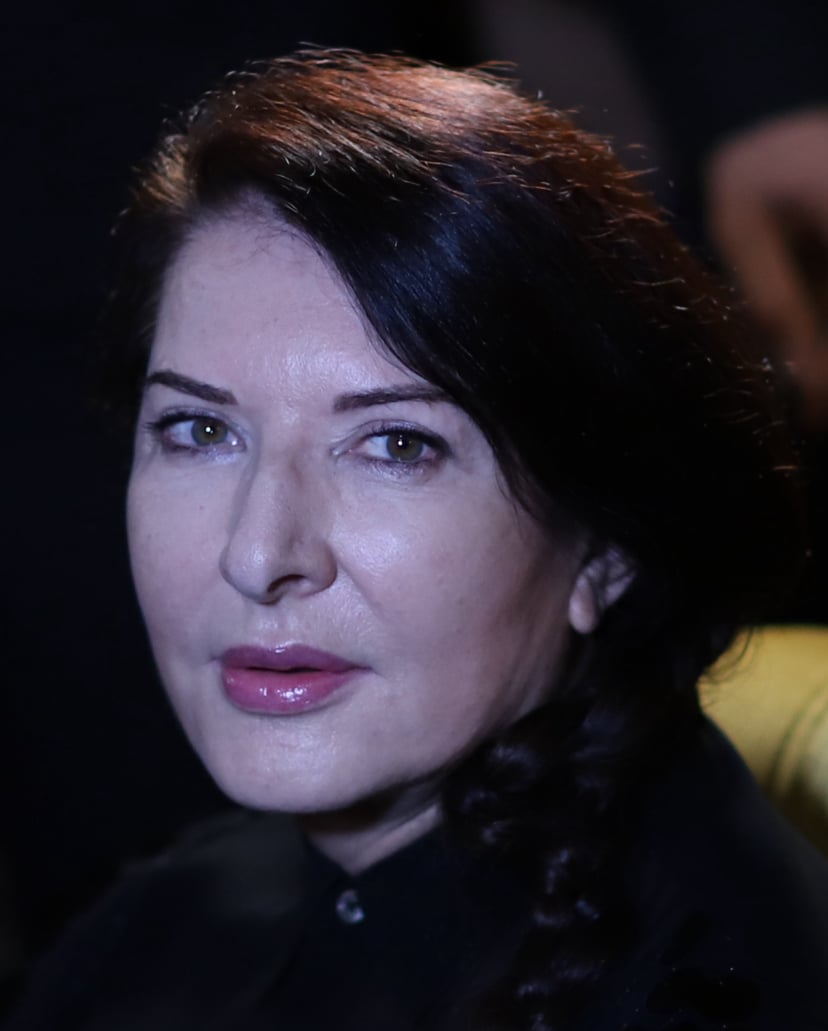
Marina Abramović

Marina Abramović | |
|---|---|
| Born | (1946-11-30)November 30, 1946 Belgrade, PR Serbia, FPR Yugoslavia |
| Education |
|
| Known for | Performance Art, Body Art, Feminist Art, Art Film, Endurance art |
Notable work |
|
| Movement | Conceptual art |
| Spouse(s) | Neša Paripović (m. 1971;div. 1976) |
| Website | www.marinaabramovic.com [109] |
Marina Abramović (Serbian Cyrillic: Марина Абрамовић, pronounced [marǐːna abrǎːmoʋitɕ]; born November 30, 1946) is a Serbian performance artist, writer, and art filmmaker.[1] Her work explores body art, endurance art and feminist art, the relationship between performer and audience, the limits of the body, and the possibilities of the mind. Being active for over four decades, Abramović refers to herself as the "grandmother of performance art".[2] She pioneered a new notion of identity by bringing in the participation of observers, focusing on "confronting pain, blood, and physical limits of the body".[3]
Marina Abramović | |
|---|---|
| Born | (1946-11-30)November 30, 1946 Belgrade, PR Serbia, FPR Yugoslavia |
| Education |
|
| Known for | Performance Art, Body Art, Feminist Art, Art Film, Endurance art |
Notable work |
|
| Movement | Conceptual art |
| Spouse(s) | Neša Paripović (m. 1971;div. 1976) |
| Website | www.marinaabramovic.com [109] |
Early life, Education and Teaching
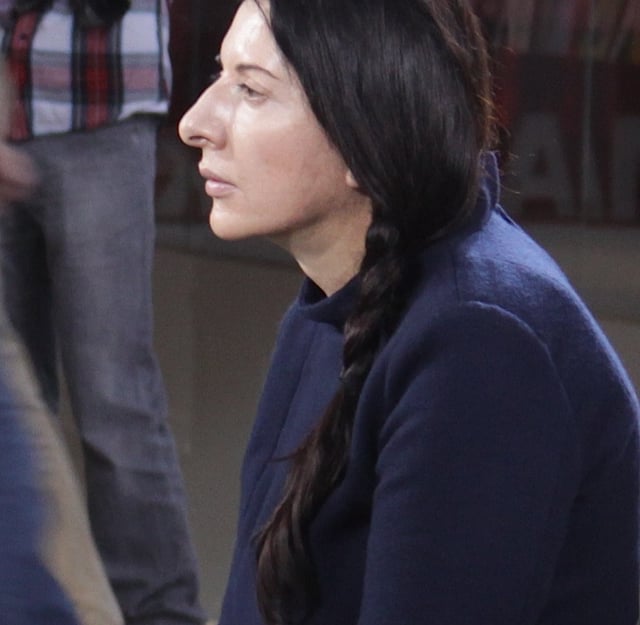
At the Museum of Modern Art, New York, 2010
Abramović was born in Belgrade, Serbia, former Yugoslavia on November 30, 1946. In an interview, Abramović described her family as having been "Red bourgeoisie."[4] Her great-uncle was Varnava, Serbian Patriarch of the Serbian Orthodox Church.[5] Both of her parents, Danica Rosić and Vojin Abramović[4] were Yugoslav Partisans[6] during the Second World War. After the war, Abramović's parents became "national heroes" and were given positions in the post-war Yugoslavian government.[4]
Abramović was raised by her grandparents until she was six years old.[7] Her grandmother was deeply religious and Abramović "spent [her] childhood in a church following [her] grandmother's rituals – candles in the morning, the priest coming for different occasions".[7] At the age of six, when Abramović's brother was born, she began living with her parents and took piano, French, and English lessons.[7] While she did not take art lessons, she took an early interest in art[7] and enjoyed painting as a child.[4]
Life in Abramović's parental home under her mother's strict supervision was difficult.[8] When Abramović was a child, her mother beat her for "supposedly showing off".[4] In an interview published in 1998, Abramović described how her "mother took complete military-style control of me and my brother. I was not allowed to leave the house after 10 o'clock at night until I was 29 years old. ... [A]ll the performances in Yugoslavia I did before 10 o'clock in the evening because I had to be home then. It's completely insane, but all of my cutting myself, whipping myself, burning myself, almost losing my life in 'The Firestar' – everything was done before 10 in the evening."[9]
She was a student at the Academy of Fine Arts in Belgrade from 1965 to 1970. She completed her post-graduate studies at the Academy of Fine Arts in Zagreb, SR Croatia in 1972. Then she returned to SR Serbia and, from 1973 to 1975, she taught at the Academy of Fine Arts at Novi Sad, while implementing her first solo performances.
After Abramović was married to Neša Paripović between 1971 and 1976, in 1976, she went to Amsterdam to perform a piece (later claiming on the day of her birthday)[11] then decided to move there permanently.
From 1990–1995 Abramović was a visiting professor at the Académie des Beaux-Arts in Paris and at the Berlin University of the Arts. From 1992–1996 she was a visiting professor at the Hochschule für bildende Künste Hamburg and from 1997–2004 she was a professor for performance-art at the Hochschule für bildende Künste Braunschweig.[12][13]
Career
Rhythm 10, 1973
In her first performance in Edinburgh in 1973,[14] Abramović explored elements of ritual and gesture. Making use of twenty knives and two tape recorders, the artist played the Russian game, in which rhythmic knife jabs are aimed between the splayed fingers of one's hand. Each time she cut herself, she would pick up a new knife from the row of twenty she had set up, and record the operation. After cutting herself twenty times, she replayed the tape, listened to the sounds, and tried to repeat the same movements, attempting to replicate the mistakes, merging past and present. She set out to explore the physical and mental limitations of the body – the pain and the sounds of the stabbing; the double sounds from the history and the replication. With this piece, Abramović began to consider the state of consciousness of the performer. "Once you enter into the performance state you can push your body to do things you absolutely could never normally do."[15]
Rhythm 5, 1974
In this performance, Abramović sought to re-evoke the energy of extreme bodily pain, using a large petroleum-drenched star, which the artist lit on fire at the start of the performance. Standing outside the star, Abramović cut her nails, toenails, and hair. When finished with each, she threw the clippings into the flames, creating a burst of light each time. Burning the communist five-pointed star represented a physical and mental purification, while also addressing the political traditions of her past. In the final act of purification, Abramović leapt across the flames, propelling herself into the center of the large star. Due to the light and smoke given off by the fire, the observing audience did not realize that, once inside the star, the artist had lost consciousness from lack of oxygen. Some members of the audience realized what had occurred only when the flames came very near to her body and she remained inert. A doctor and several members of the audience intervened and extricated her from the star.
Abramović later commented upon this experience: "I was very angry because I understood there is a physical limit. When you lose consciousness you can't be present, you can't perform."[16]
Rhythm 2, 1974
Prompted by her loss of consciousness during Rhythm 5, Abramović devised the two-part Rhythm 2 to incorporate a state of unconsciousness in a performance. She performed the work at the Gallery of Contemporary Art in Zagreb, in 1974. In Part I, which had a duration of 50 minutes, she ingested a medication she describes as 'given to patients who suffer from catatonia, to force them to change the positions of their bodies.' The medication caused her muscles to contract violently, and she lost complete control over her body while remaining aware of what was going on. After a ten-minute break, she took a second medication 'given to schizophrenic patients with violent behavior disorders to calm them down.' The performance ended after five hours when the medication wore off.[17][18][19]
Rhythm 4, 1974
In this piece, Abramović kneeled alone and naked in a room with a high-power industrial fan. She approached the fan slowly, attempting to breathe in as much air as possible to push the limits of her lungs. Soon after she lost consciousness.[20]
Rhythm 0, 1974
To test the limits of the relationship between performer and audience, Abramović developed one of her most challenging (and best-known) performances. She assigned a passive role to herself, with the public being the force which would act on her. Abramović placed on a table 72 objects that people were allowed to use (a sign informed them) in any way that they chose. Some of these were objects that could give pleasure, while others could be wielded to inflict pain, or to harm her. Among them were a rose, a feather, honey, a whip, olive oil, scissors, a scalpel, a gun and a single bullet. For six hours the artist allowed the audience members to manipulate her body and actions. This tested how vulnerable and aggressive the human subject could be when hidden from social consequences.[3] By the end of the performance, her body was stripped, attacked, and devalued into an image that Abramović described as the "Madonna, mother, and whore."[3] Additionally, markings of aggression were apparent on the artist's body. There were cuts on her neck made by audience members, and her clothes were cut off her body.
In her works, Abramović affirms her identity through the perspective of others, however, more importantly by changing the roles of each player, the identity and nature of humanity at large is unraveled and showcased. By doing so, the individual experience morphs into a collective one and creates a powerful message.[3] Abramović's art also represents the objectification of the female body, as she remains motionless and allows the spectators to do as they please with her body, pushing the limits of what one would consider acceptable. This type of representation also reflects key political issues such as BDSM, which complicates and questions the relation between art versus sexuality and public discourse.
Initially, members of the audience reacted with caution and modesty, but as time passed (and the artist remained passive) people began to act more aggressively. As Abramović described it later: "What I learned was that ... if you leave it up to the audience, they can kill you. ... I felt really violated: they cut up my clothes, stuck rose thorns in my stomach, one person aimed the gun at my head, and another took it away. It created an aggressive atmosphere. After exactly 6 hours, as planned, I stood up and started walking toward the audience. Everyone ran away, to escape an actual confrontation."[21]
Cleaning the Mirror, 1995
Cleaning the Mirror consisted of five monitors playing footage in which Abramović scrubs a grimy human skeleton in her lap. She vigorously brushes the different parts of the skeleton with soapy water. Each monitor is dedicated to one part of the skeleton: the head, the pelvis, the ribs, the hands, and the feet. Each video is filmed with its own sound, creating an overlap. As the skeleton becomes cleaner, Abramović becomes covered in the grayish dirt that was once covering the skeleton. This three-hour performance is filled with metaphors of the Tibetan death rites that prepare disciples to become one with their own mortality. The piece consists of a three-piece series. Cleaning the Mirror #1 was performed at the Museum of Modern Art, consisting of three hours. Cleaning the Mirror #2 consists of 90 minutes performed at Oxford University. Cleaning the Mirror #3 was performed at Pitt Rivers Museum for five hours.[22]
Spirit Cooking, 1996
Abramović worked with Jacob Samuel to produce a cookbook of "aphrodisiac recipes" called Spirit Cooking in 1996. These "recipes" were meant to be "evocative instructions for actions or for thoughts".[23] For example, one of the recipes calls for "13,000 grams of jealousy," while another says to "mix fresh breast milk with fresh sperm milk."[24] The work was inspired by the popular belief that ghosts feed off intangible things like light, sound, and emotions.[25]
In 1997, Abramović created a multimedia Spirit Cooking installation. This was originally installed in the Zerynthia Associazione per l'Arte Contemporanea in Rome, Italy and included white gallery walls with "enigmatically violent recipe instructions" painted in pig's blood.[26] According to Alexxa Gotthardt, the work is "a comment on humanity's reliance on ritual to organize and legitimize our lives and contain our bodies".[27]
Abramovic also published a Spirit Cooking cookbook, containing comico-mystical, self-help instructions that are meant to be just poetry. Spirit Cooking later evolved into a form of dinner party entertainment that Abramovic occasionally lays on for collectors, donors, and friends.[28]
Works with Ulay (Uwe Laysiepen)
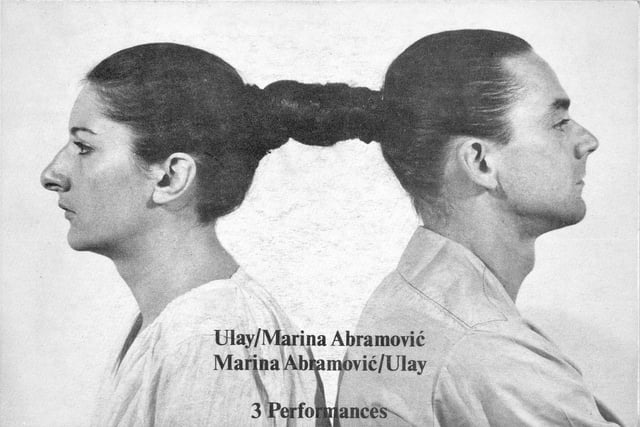
Marina Abramović and Uwe Laysiepen 1978
In 1976, after moving to Amsterdam, Abramović met the West German performance artist Uwe Laysiepen, who went by the single name Ulay. They began living and performing together that year. When Abramović and Ulay began their collaboration,[11] the main concepts they explored were the ego and artistic identity. They created "relation works" characterized by constant movement, change, process and "art vital".[29] This was the beginning of a decade of influential collaborative work. Each performer was interested in the traditions of their cultural heritage and the individual's desire for ritual. Consequently, they decided to form a collective being called "The Other", and spoke of themselves as parts of a "two-headed body".[30] They dressed and behaved like twins and created a relationship of complete trust. As they defined this phantom identity, their individual identities became less accessible. In an analysis of phantom artistic identities, Charles Green has noted that this allowed a deeper understanding of the artist as performer, for it revealed a way of "having the artistic self-made available for self-scrutiny".[31]
The work of Abramović and Ulay tested the physical limits of the body and explored male and female principles, psychic energy, transcendental meditation and nonverbal communication.[29] While some critics have explored the idea of a hermaphroditic state of being as a feminist statement, Abramović herself denies considering this as a conscious concept. Her body studies, she insists, have always been concerned primarily with the body as the unit of an individual, a tendency she traces to her parents' military pasts. Rather than concerning themselves with gender ideologies, Abramović/Ulay explored extreme states of consciousness and their relationship to architectural space. They devised a series of works in which their bodies created additional spaces for audience interaction. In discussing this phase of her performance history, she has said: "The main problem in this relationship was what to do with the two artists' egos. I had to find out how to put my ego down, as did he, to create something like a hermaphroditic state of being that we called the death self."[32]
In Relation in Space (1976) they ran into each other repeatedly for an hour – mixing male and female energy into the third component called "that self".[11]
Relation in Movement (1977) had the pair driving their car inside of a museum for 365 laps; a black liquid oozed from the car, forming a kind of sculpture, each lap representing a year. (After 365 laps the idea was that they entered the New Millennium.)
In Relation in Time (1977) they sat back to back, tied together by their ponytails for sixteen hours. They then allowed the public to enter the room to see if they could use the energy of the public to push their limits even further.[33]
To create Breathing In/Breathing Out the two artists devised a piece in which they connected their mouths and took in each other's exhaled breaths until they had used up all of the available oxygen. Seventeen minutes after the beginning of the performance they both fell to the floor unconscious, their lungs having filled with carbon dioxide. This personal piece explored the idea of an individual's ability to absorb the life of another person, exchanging and destroying it.
In Imponderabilia (1977, reenacted in 2010) two performers, both completely nude, stand in a doorway. The public must squeeze between them in order to pass, and in doing so choose which one of them to face.[11]
In AAA-AAA (1978) the two artists stood opposite each other and made long sounds with their mouths open. They gradually moved closer and closer, until they were eventually yelling directly into each other's mouths.[33] This piece demonstrated their interest in endurance and duration.[33]
In 1980, they performed Rest Energy, in an art exhibition in Dublin, where both balanced each other on opposite sides of a drawn bow and arrow, with the arrow pointed at Abramović's heart.[11][34]
Between 1981 and 1987, the pair performed Nightsea Crossing in twenty-two performances. They sat silently across from each other in chairs for seven hours a day.[33]
In 1988, after several years of tense relations, Abramović and Ulay decided to make a spiritual journey which would end their relationship. They each walked the Great Wall of China, in a piece called Lovers, starting from the two opposite ends and meeting in the middle. As Abramović described it: "That walk became a complete personal drama. Ulay started from the Gobi Desert and I from the Yellow Sea. After each of us walked 2500 km, we met in the middle and said good-bye."[35] She has said that she conceived this walk in a dream, and it provided what she thought was an appropriate, romantic ending to a relationship full of mysticism, energy, and attraction. She later described the process: "We needed a certain form of ending, after this huge distance walking towards each other. It is very human. It is in a way more dramatic, more like a film ending ... Because in the end, you are really alone, whatever you do."[35] She reported that during her walk she was reinterpreting her connection to the physical world and to nature. She felt that the metals in the ground influenced her mood and state of being; she also pondered the Chinese myths in which the Great Wall has been described as a "dragon of energy." It took the couple eight years to acquire permission from the Chinese government to perform the work, by the time of which their relationship had completely dissolved.
At her 2010 MoMA retrospective, Abramović performed The Artist Is Present, in which she shared a period of silence with each stranger who sat in front of her. Although "they met and talked the morning of the opening",[36] Abramović had a deeply emotional reaction to Ulay when he arrived at her performance, reaching out to him across the table between them; the video of the event went viral.[37]
In November 2015, Ulay took Abramović to court, claiming she had paid him insufficient royalties according to the terms of a 1999 contract covering sales of their joint works.[38][39] In September 2016, a Dutch court ordered Abramović to pay €250,000 to former co-creator and lover Ulay as his share of sales of artistic collaborations over their joint works. In its ruling, the court in Amsterdam found that Ulay was entitled to royalties of 20% net on the sales of their works, as specified in the original 1999 contract, and ordered Abramović to backdate royalties of more than €250,000, as well as more than €23,000 in legal costs.[40] Additionally, she was ordered to provide full accreditation to joint works listed as by "Ulay/Abramović" covering the period from 1976 to 1980, and "Abramović/Ulay" for those from 1981 to 1988.
Seven Easy Pieces, 2005
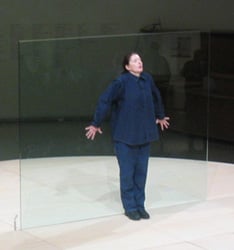
Abramović performing Bruce Nauman's Body Pressure, Guggenheim Museum, 2005
Beginning on November 9, 2005, Abramović presented Seven Easy Pieces at the Guggenheim Museum in New York City. On seven consecutive nights for seven hours she recreated the works of five artists first performed in the '60s and '70s, in addition to re-performing her own Lips of Thomas and introducing a new performance on the last night. The performances were arduous, requiring both the physical and the mental concentration of the artist. Included in Abramović's performances were recreations of Gina Pane's Self-Portraits, which required lying on a bed frame suspended over a grid of lit candles, and of Vito Acconci's 1972 performance in which the artist masturbated under the floorboards of a gallery as visitors walked overhead. It is argued that Abramović re-performed these works as a series of homages to the past, though many of the performances were altered from their originals.[41]
Here is a full list of the works performed:
Bruce Nauman's Body Pressure (1974)
Vito Acconci's Seedbed (1972)
Valie Export's Action Pants: Genital Panic (1969)
Gina Pane's The Conditioning (1973)
Joseph Beuys's How to Explain Pictures to a Dead Hare (1965)
Abramović's own Thomas Lips (1975)
Abramović's own Entering the Other Side (2005)
The Artist Is Present: March–May 2010
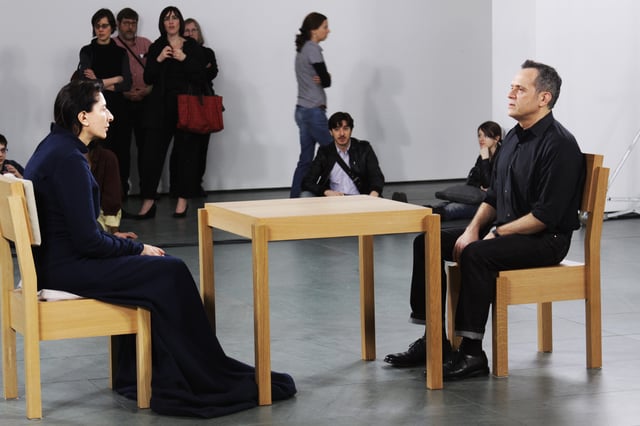
Abramović performing The Artist Is Present, Museum of Modern Art, March 2010
From March 14 to May 31, 2010, the Museum of Modern Art held a major retrospective and performance recreation of Abramović's work, the biggest exhibition of performance art in MoMA's history, curated by Klaus Biesenbach.[42] Biesenbach also provided the title for the performance, which referred to the fact that during the entire performance "the artist would be right there in the gallery or the museum."[43]
During the run of the exhibition, Abramović performed The Artist Is Present,[44] a 736-hour and 30-minute static, silent piece, in which she sat immobile in the museum's atrium while spectators were invited to take turns sitting opposite her.[45] Ulay made a surprise appearance at the opening night of the show.[46]
Abramović sat in a rectangle drawn with tape in the floor of the second floor atrium of the MoMA; theater lights shone on her sitting in a chair and a chair opposite her.[47] Visitors waiting in line were invited to sit individually across from the artist while she maintained eye contact with them. Visitors began crowding the atrium within days of the show opening, some gathering before the exhibit opened each morning to rush for a more preferable place in the line to sit with Abramović. Most visitors sat with the artist for five minutes or less and the line attracted no attention from museum security except for the last day of the exhibition when a visitor vomited in line and another began to disrobe. Tensions among visitors in line could have arisen from an understanding that for every minute each person in line spent with Abramović, there would be that many fewer minutes in the day for those further back in line to spend with the artist. Due to the strenuous nature of sitting for hours at a time, art-enthusiasts have speculated as to whether Abramović wore an adult diaper to eliminate the need to move to urinate. Others have highlighted the movements she made in between sitters as a focus of analysis, as the only variations in the artist between sitters were when she would cry if a sitter cried and her moment of physical contact with Ulay, one of the earliest visitors to the exhibition. Abramović sat across from 1,545 sitters, including Klaus Biesenbach, James Franco, Lou Reed, Alan Rickman, Jemima Kirke, Jennifer Carpenter and Björk; sitters were asked not to touch or speak to the artist. By the end of the exhibit, hundreds of visitors were lining up outside the museum overnight to secure a spot in line the next morning. Abramović concluded the performance by slipping from the chair where she was seated and rising to a cheering crowd more than ten people deep.
A support group for the "sitters", "Sitting with Marina", was established on Facebook,[48] as was the blog "Marina Abramović made me cry".[49] The Italian photographer Marco Anelli took portraits of every person who sat opposite Abramović, which were published on Flickr,[50] compiled in a book[51] and featured in an exhibition at the Danziger Gallery in New York.[52]
Abramović said the show changed her life "completely – every possible element, every physical emotion", and that Lady Gaga saw it helped boost her popularity: "So the kids from 12 and 14 years old to about 18, the public who normally don't go to the museum, who don't give a shit about performance art or don't even know what it is, started coming because of Lady Gaga. And they saw the show and then they started coming back. And that's how I get a whole new audience."[53] In September 2011, a video game version of Abramović's performance was released by Pippin Barr.[54]
Other
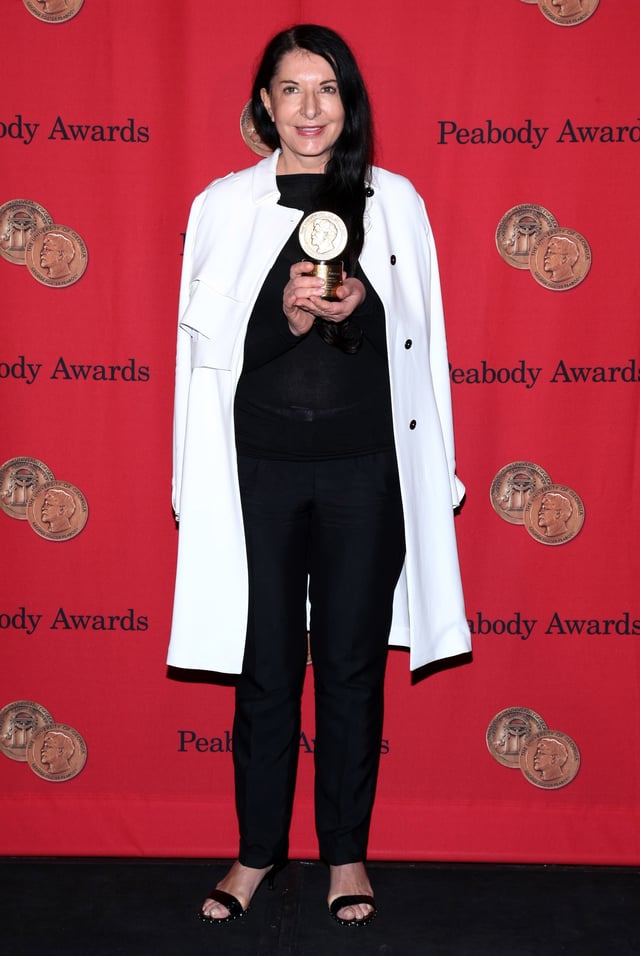
Marina Abramović at the 72nd Annual Peabody Awards
In 2009, Abramović was featured in Chiara Clemente's documentary Our City Dreams and a book of the same name. The five featured artists – also including Swoon, Ghada Amer, Kiki Smith, and Nancy Spero – "each possess a passion for making work that is inseparable from their devotion to New York," according to the publisher.[55] Abramović is also the subject of an independent feature documentary movie entitled Marina Abramović: The Artist Is Present, which is based on her life and performance at her retrospective "The Artist Is Present" at the Museum of Modern Art in 2010. The film was broadcast in the United States on HBO[56] and won a Peabody Award in 2012.[57] In January 2011, Abramović was on the cover of Serbian ELLE, photographed by Dušan Reljin. Kim Stanley Robinson's science fiction novel 2312 mentions a style of performance art pieces known as "abramovics."
A world premiere installation by Abramović was featured at Toronto's Trinity Bellwoods Park as part of the Luminato Festival in June 2013. Abramović is also co-creator, along with Robert Wilson of the theatrical production The Life and Death of Marina Abramović, which had its North American premiere at the festival, and at the Park Avenue Armory in December.[58]
Abramović attempted to create the Marina Abramović Institute (MAI), a nonprofit foundation for performance art, in a 33,000 square-foot space in Hudson, New York.[59] She also founded a performance institute in San Francisco.[29] She is a patron of the London-based Live Art Development Agency.[60]
In March 2015, Abramović presented her TED talk titled, "An art made of trust, vulnerability and connection."[63]
Marina Abramović is also a recurring character in the underground comic book "The Serbian Life".
Refused proposals
Abramović had proposed some solo performances during her career that never were performed. One proposal was titled "Come to Wash with Me". This performance would take place in a gallery space that was to be transformed into a laundry with sinks placed all around the walls of the gallery. The public would enter the space and be asked to take off all of their clothes and give them to Abramović. The individuals would then wait around as she would wash, dry and iron their clothes for them, and once she was done, she would give them back their clothing, and they could get dressed and then leave. She proposed this in 1969 for the Galerija Doma Omladine in Belgrade. The proposal was refused.
In 1970 she proposed a similar idea to the same gallery that was also refused. The piece was untitled. Abramović would stand in front of the public dressed in her regular clothing. Present on the side of the stage was a clothes rack adorned with clothing that her mother wanted her to wear. She would take the clothing one by one and change into them, then stand to face the public for a while. "From the right pocket of my skirt I take a gun. From the left pocket of my skirt I take a bullet. I put the bullet into the chamber and turn it. I place the gun to my temple. I pull the trigger." The performance had two possible outcomes.[64]
The list of Mother's clothes included:
Heavy brown pin for the hair
White cotton blouse with red dots
Light pink bra – 2 sizes too big
Dark pink heavy flannel slip – three sizes too big
Dark blue skirt – mid-calf
Skin colour heavy synthetic stockings
Heavy orthopaedic shoes with laces
Collaborations
In July 2013, Abramović worked with pop singer Lady Gaga on the singer's third album Artpop. Gaga's work with Abramović, as well as artists Jeff Koons and Robert Wilson, was displayed at an event titled "ArtRave" on November 10.[68] Furthermore, both have collaborated on projects supporting the Marina Abramović Institute, including Gaga's participation in an 'Abramović Method' video and a non-stop reading of Stanisław Lem's sci-fi novel, Solaris.[69]
Also in July 2013, Jay-Z showcased an Abramović-inspired piece at Pace Gallery in New York City. He performed his art-inspired track "Picasso Baby" for six straight hours.[70] During the performance, Abramović and several figures in the art world were invited to dance with him standing face to face.[71] The footage was later turned into a music video. She allowed Jay-Z to adapt "The Artist Is Present" under the condition that he would donate to the Marina Abramović Institute. Abramović stated that Jay-Z did not live up to his end of the deal, describing the performance as a "one-way transaction".[72] However, two years later in 2015, Abramović publicly issued an apology stating she was never informed of Jay-Z's sizable donation.[73]
Controversy
Abramović sparked controversy in August 2016 when passages from an early draft of her memoir were released, in which—based on notes from her 1979 initial encounter with Aboriginal Australians—she compared them to dinosaurs and observed that "they have big torsos (just one bad result of their encounter with Western civilisation is a high sugar diet that bloats their bodies) and sticklike legs". She responded to the controversy on Facebook, saying she had "the greatest respect for the Aborigine people, to whom [she] owed everything".[74]
Among a tranche of emails stolen from John Podesta and published by WikiLeaks in the run-up to the 2016 US presidential election was a message from Abramović to Podesta's brother discussing an invitation to a spirit cooking. This was interpreted by conspiracy theorist Alex Jones as an invitation to a satanic ritual, and presented by Jones and others as proof that Democratic candidate Hillary Clinton had links with the occult.[75] In 2013 Reddit Q&A in response to question about occult in contemporary art she said: "Everything depends on which context you are doing what you are doing. If you are doing the occult magic in the context of art or in a gallery, then it is the art. If you are doing it in different context, in spiritual circles or private house or on TV shows, it is not art. The intention, the context for what is made, and where it is made defines what art is or not".[76] Scholars noted that in fact Abramović has a lifelong interest in esotericism and Spiritualism, but this should not be confused with Satanism, which is a different system of occult beliefs.[77]
Films
Abramović directed a segment Balkan Erotic Epic in Destricted, a compilation of erotic films made in 2006.[78] In 2008 she directed a segment Dangerous Games in another film compilation Stories on Human Rights.[79] She also acted in a five-minute short film Antony and the Johnsons: Cut the World.[80]
Awards
Golden Lion, XLVII Venice Biennale, 1997[81]
Niedersächsischer Kunstpreis, 2002[82]
New York Dance and Performance Awards (The Bessies), 2002[82]
International Association of Art Critics, Best Show in a Commercial Gallery Award, 2003
Austrian Decoration for Science and Art (2008)[83]
Honorary Doctorate of Arts, University of Plymouth UK, September 25, 2009[84]
Cultural Leadership Award, American Federation of Arts, October 26, 2011
Honorary Doctorate of Arts, Instituto Superior de Arte, Cuba, May 14, 2012
'July 13' Lifetime Achievement Awards, Podgorica, Montenegro, October 1, 2012
The Karić brothers award (category art and culture), 2012.
Berliner Bear (2012; not to be confused with the Silver and Golden Bear at the Berlin Film Festival; a cultural award of the German tabloid BZ)
Peabody Award, 2012
